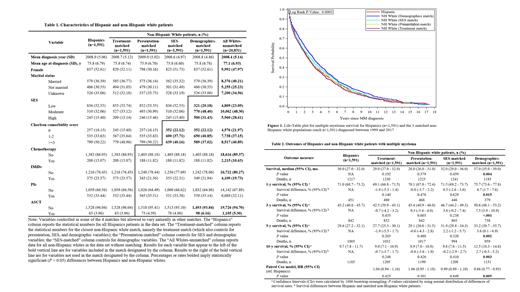Abstract
Background: Recent treatment advances have greatly improved the survival in multiple myeloma (MM), the second most common hematologic malignancy in the US. However, large racial and ethnic disparities in MM survival still exist. Previous Surveillance, Epidemiology and End Results (SEER)-based analyses suggest Hispanics have lower utilization rate of effective antimyeloma therapies and worse overall survival than non-Hispanic whites (NHWs) with MM, but the factors associated with these disparities are not clear. To understand the nature of the disparity, we used a novel tapered matching approach to examine the sequential effects of demographics, clinical, and treatment-related factors on the disparities in survival time between Hispanic and NHW patients with MM.
Methods: We identified 1,591 Hispanic and 20,831 NHW patients, 65 years or older, diagnosed with MM between 1999 and 2017 in the SEER-Medicare database (2020 release). MM diagnosis was defined by International Classification of Diseases for Oncology, Third Edition using topography codes (C42.1) and histologic codes (M9732/3). All patients have continuous enrollment in Medicare parts A and B from 12 months before MM diagnosis to at least 12 months after MM diagnosis or death, whichever occurs first. Patients were followed up until death from any cause, maximum claim date, or December 31, 2018. Four sets of 1,591 NHW patients were matched sequentially to the same set of 1,591 Hispanic patients, based on demographics (age, sex, year of diagnosis, SEER site, and marital status), socioeconomic status (SES, demographic variables plus SES), presentation (SES variables plus comorbidities) and treatment (presentation variables plus chemotherapy, proteasome inhibitors (PIs), immunomodulatory drugs (IMiDs) and autologous stem cell transplantation (ASCT)). All matching was performed using the OPTNET procedure in SAS 9.4 to identify the optimal 1:1 matched cohort that had the minimal total distance between Hispanic and NHW matched pairs. We used paired Cox proportional hazards models to examine survival over time and hazard ratios (HRs) and used the bootstrap method to obtain standard errors for the paired differences in survival.
Results: Overall, compared to the unmatched NHWs, Hispanics were younger on average (75.8 vs. 77.1 years), more likely to be female (52.6% vs. 48.0%), to have low SES (52.6% vs. 23.1%), but less likely to be married at diagnosis (36.4% vs. 40.2%). Hispanics also had more comorbidities (Comorbidity Index = 0, 16.2% vs. 22.0%), but were less likely to receive ASCT (4.0% vs. 5.3%) than NHWs (all P < 0.05, Table 1). During follow-up evaluation, 1,217 of 1,591 Hispanics (76.5%) and 16,479 of 20,831 NHWs (79.1%) died. Compared with demographics matched NHWs, Hispanics had a significantly shorter median survival (30.0 vs. 37.0 months; P=0.004). After matching on SES, the difference in median survival was no longer significant (P=0.46), neither in the matching on presentation (P=0.38) nor treatment (P=0.19). The absolute difference in 5-year survival between Hispanics (29.6%) and NHWs (33.2%) was 3.6% (95%CI, 0.1%-6.9%, P = 0.002) in the demographics match. After we matched for SES, the difference in 5-year survival was reduced to 2.2% (95%CI, -1.2%-5.7%) and was not statistically significant (P = 0.32). No 5-year survival difference was observed in the presentation or treatment match (both P > 0.05) (Table 2 and Figure 1). We further conducted stratified analysis by SES and found that among those with low SES, NHWs still had a marginally significant longer median survival (30.0 vs 26.0 months, P=0.06) and better 5-year survival (28.4% vs. 25.5%, P =0.07) than Hispanics in the demographics match. Further matching on presentation and treatment eliminated the survival differences between NHWs and Hispanics who were both at low SES. However, if NHWs and Hispanics were both at high SES, they experienced similar survival across the demographics, presentation and treatment match (all P > 0.1).
Conclusions: In the SEER-Medicare database, SES could account for the disparities in survival time between Hispanic and NHW patients with MM. While SES is an important prognostic factor of MM, additional social, clinical, and biological factors also need to be investigated to understand the mechanisms underlying survival disparity in patients with low SES, so proper intervention and policy development could be implemented.
Mohan: Medical College of Wisconsin: Current Employment. D'Souza: Imbrium, Pfizer, BMS: Membership on an entity's Board of Directors or advisory committees; Sanofi, Takeda, Teneobio, CAELUM, Prothena: Research Funding; Janssen, Prothena: Consultancy. Dhakal: Fate: Research Funding; Carsgen: Research Funding; Natera: Membership on an entity's Board of Directors or advisory committees; Takeda: Membership on an entity's Board of Directors or advisory committees, Research Funding; Amgen: Membership on an entity's Board of Directors or advisory committees, Research Funding; Janssen: Membership on an entity's Board of Directors or advisory committees, Research Funding; Karyopharm: Speakers Bureau; Sanofi: Research Funding, Speakers Bureau; BMS: Honoraria, Speakers Bureau; GSK: Honoraria, Membership on an entity's Board of Directors or advisory committees, Research Funding. Hari: Millenium: Membership on an entity's Board of Directors or advisory committees, Research Funding; Janssen: Honoraria, Membership on an entity's Board of Directors or advisory committees, Other, Research Funding, Speakers Bureau; Adaptive Biotech: Honoraria, Membership on an entity's Board of Directors or advisory committees, Speakers Bureau; Sanofi: Honoraria, Membership on an entity's Board of Directors or advisory committees, Research Funding, Speakers Bureau; GSK: Consultancy, Membership on an entity's Board of Directors or advisory committees, Other, Research Funding, Speakers Bureau; Amgen: Consultancy, Honoraria, Membership on an entity's Board of Directors or advisory committees, Other, Research Funding, Speakers Bureau; Karyopharm: Consultancy; Oncopeptides: Honoraria, Membership on an entity's Board of Directors or advisory committees, Speakers Bureau; Takeda: Consultancy, Honoraria, Membership on an entity's Board of Directors or advisory committees, Other, Research Funding, Speakers Bureau; Celgene-BMS: Consultancy, Honoraria, Membership on an entity's Board of Directors or advisory committees, Other, Research Funding, Speakers Bureau.


This feature is available to Subscribers Only
Sign In or Create an Account Close Modal